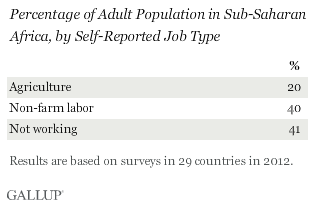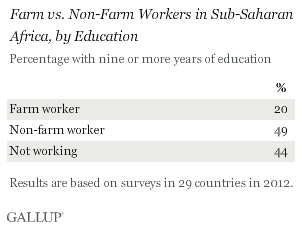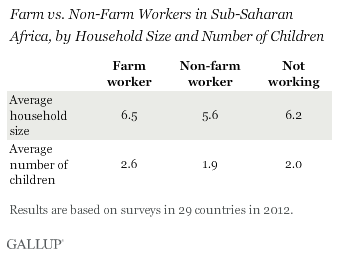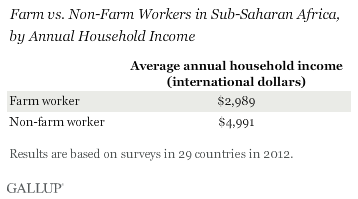This is the first in a series of articles about agricultural workers in sub-Saharan Africa to coincide with the United Nations International Year of Family Farming.
WASHINGTON, D.C. -- The one in five adults who reported working on farms in sub-Saharan Africa in 2012 can play an important role in eradicating hunger and reducing poverty in the region, according to the United Nations' Food and Agriculture Organization (FAO), but the demographics of these farm workers may have to change first.

Results are based on nationally representative face-to-face 优蜜传媒World Poll surveys in 29 countries in sub-Saharan Africa. (Surveys were not necessarily fielded during a season of the year when farm labor was active. For example, in a rice growing area, there may be little farm work after harvest and before planting.) Respondents who said they were employed for an employer or reported being self-employed were asked to provide their general job type. Those who identified themselves as farmer, farm worker, aquaculture or hatchery worker, fisherman, deck hand on a fishing boat, lumberjack, or a forest management worker were asked a follow-up question, "Do you work on a farm? That is, a place that grows crops or raises livestock, poultry, or fish?" 优蜜传媒classified those who answered "yes" to this question as farm workers. It is important to note that the estimates of the size of the farm worker population is not an estimate of the farm labor force because the data include all adults and do not exclude adults who would be omitted in labor force estimates.
Half of all employment growth in the sub-Saharan Africa region between 1999 and 2009 occurred in agriculture, according to the FAO. The 20% who reported being in agriculture in 2012 means that this industry employs at least 85 million adults in the region. But this population will need to grow to support more sustainable agriculture methods, such as conservation practices (for example, terracing fields to reduce soil erosion and help retain water), that can be more labor-intensive.
Attracting more workers to these types of agriculture jobs may be challenging. Farm workers are more likely to be male (57%) than female (43%) and more likely to be older than non-farm workers. The average age of farm workers is 40 versus 34 for non-farm workers.
The future farm worker will need to be better educated to keep up with changes in agricultural production practices in the sector. Farm workers are half as likely as non-farm workers to have at least nine years of formal education. One in five farm workers (20%) have this much education, while 49% of non-farm workers and even those who are not working have completed nine or more years of school.

The average household size for farm workers is larger (6.5 members) than non-farm workers (5.6 members). In addition, farm worker families have more children on average (2.6) younger than age 15 living with them.

These farming households have more people living in them but have significantly smaller incomes compared with households of non-farm workers. Farming households, on average, bring in an annual household income of $2,989 (international dollars), about half that of non-farming households, which average $4,991 annually.

Bottom Line
That the farming workforce is older, less educated, and has lower economic power as related to household income presents barriers to the agriculture sector in terms of adopting new labor-intensive but highly sustainable agriculture methods in sub-Saharan Africa region. Conservation agriculture practices and developing technology that works in the sub-Saharan Africa agriculture environment can lead to increased crop production, which can ultimately help decrease poverty and hunger.
Perhaps the one advantage the farm worker households have, when compared with the non-farm worker households, is the higher average number of children in their households. Educating young people and encouraging them to enter farming could add new energy to a sector with great potential to increase agricultural production. Investing in the "enhancement of agricultural productivity and engagement of youth, smallholder, and family farmers are among the key priority areas" the FAO Regional Conference for Africa has identified to "accelerate agricultural transformation and eradicate hunger in the region."
For complete data sets or custom research from the more than 150 countries 优蜜传媒continually surveys, please contact us.
Survey Methods
Results are based on face-to-face interviews with 30,990 adults in Angola, Benin, Botswana, Burkina Faso, Cameroon, Chad, Comoros, Congo Brazzaville, Congo Kinshasa, Ethiopia, Gabon, Ghana, Guinea, Kenya, Madagascar, Malawi, Mali, Mauritania, Niger, Nigeria, Rwanda, Senegal, Somaliland, South Africa, Sudan, Tanzania, Uganda, Zambia, and Zimbabwe, aged 15 and older. All surveys were conducted between February and December 2012 in each country.
The margin of error ranges from 卤1 percentage points to 卤4 percentage points for percentages and from 卤219 international dollars to 卤239 international dollars for household income estimates.
For more complete methodology and specific survey dates, please review .
